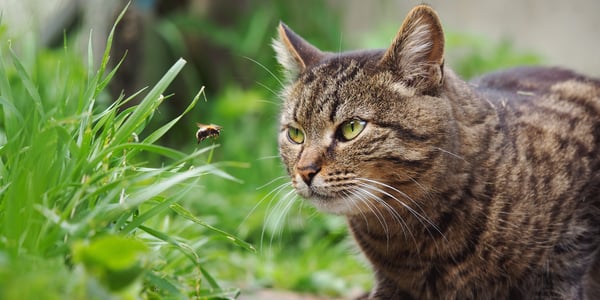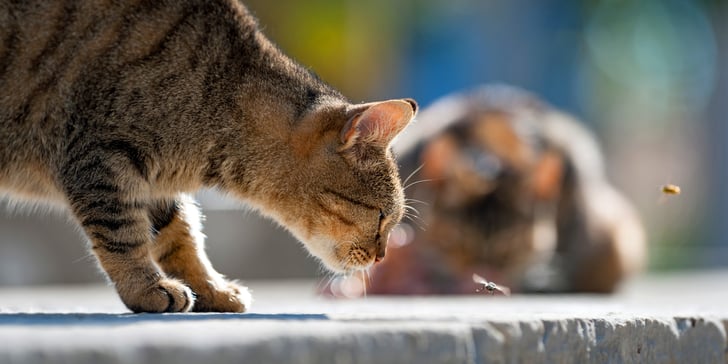How to Care for a Cat Stung by a Bee - Symptoms, Treatment, and FAQs
Index:



Introduction
One minute your feline friend is sun-bathing, the next they yelp and dash across the garden. A painful sting from a curious bee or annoyed wasp can turn any lazy afternoon upside down.
We know you love your whiskered friend to bits, so let’s walk through simple, safe steps that help care for a cat stung by a bee. We'll help guide you through the drama as it unfolds.
Key takeaways
Cats tend to paw, lick, or vocalise right after a sting, so spot these early clues fast.
Remove the stinger gently with something flat, like a credit card, then cool the spot.
First aid at home - baking soda paste, an ice pack, and keen monitoring handles most cases.
Watch for facial swelling, trouble breathing, or a collapse; these need immediate veterinary help.
Keep a calm voice; your kitty takes emotional cues from you.



Why cats get curious and stung
Felines adore movement. A buzzing striped bug looks like the world’s best toy, so your pet pounces.
Sadly, when a cat gets stung, painful lessons follow. Because a cat’s paw or face has lots of nerve endings, even a single jab feels nasty. Multiple encounters, or being stung several times, raise danger levels fast.



Symptoms of a sting
Right after your pet has been stung, you should keep a close eye on them.
Typical clues include:
Rapid licking, chewing, or nibbling of the affected area.
A sudden limp from a swollen paw.
Head shaking or frantic rubbing if the site of the sting is on the face.
Puffy eyelids or a closed eye will alert you that the sting is near the eye.
Meowing, hissing, or that low “I’m hurt” growl.
Most reactions stop at mild swelling and local irritation. Yet some cats are allergic; within the first hour, they can show some signs of an allergic reaction such as vomiting, pale gums, or collapse.



Immediate steps to take when your cat is stung by a bee
Stay calm; your pet senses your mood. Here are the essential steps to take within the golden first minutes.
1. Remove the sting. If the stinger is still lodged, scrape sideways with something rigid, like a credit card. Tweezers can pinch more venom into the skin, so avoid them if possible.
2. Neutralise. A honey bee leaves acidic venom; dab on a teaspoon of baking soda mixed with water to form a thick paste. This can help neutralise the sting and provide relief to your cat.
3. Cool the area. Wrap an ice pack in a cloth and press for two minutes on, two minutes off, to reduce swelling.
4. Stop scratching. An Elizabethan collar works wonders to protect the sore spot.
5. Monitor. Keep your cat indoors and keep a close eye for the next four hours.
6. Phone your vet clinic. If you notice a severe reaction, contact your veterinarian right away; time is of the essence.



First aid and home treatment
Medications you may use
After phoning your clinic, they might approve an age-old standby, diphenhydramine (Benadryl). Giving the right drug at the right dose matters, so never give your cat pills or any human tablets without guidance. The usual dose is 1 mg per pound, but tiny felines vary, so consult a professional for the correct dosage.
Practical comparison of care options:



Allergic reactions and anaphylactic shock
A tiny amount of venom can trigger full-body chaos. Look for them collapsing on the floor, open-mouth breathing, drooling, or gums that turn blue.
These are dramatic signs that your cat is in trouble. An emergency treatment at the clinic would be urgently required and might include oxygen, steroids, and epinephrine to counter fast-moving shock.



Preventing future drama
Trim grass and remove fallen fruit to reduce bee or wasp visits.
Close windows without screens during peak buzzing hours.
Distract with indoor play so your cat will experience fewer garden hunts.
Teach children to stay calm so they don’t wave arms and excite a wasp or bee.



Wrapping up
Now you know the drill: spot, scrape, soothe, and take your cat for urgent help if breathing falters. With simple first aid, most stings can be managed at home, but do not gamble if the cat is displaying distress.
Ready to boost peace of mind every day? You can get a quick pet insurance quote in minutes and keep your beloved whiskers safe from life’s little surprises.



FAQs
What are the signs of anaphylactic shock in cats?
Collapse, laboured breathing, vomiting, diarrhoea, and cold paws signal shock. Rush your cat to the vet immediately.
Are bee stings toxic to cats?
One sting is rarely life-threatening, but toxicity increases if multiple stings inject a large dose of venom.
How quickly will a cat react to a bee sting?
Local pain is instant. Allergy signs usually appear within the first hour.
Can cats be allergic to bee stings?
Yes. A small percentage of cats experience full anaphylaxis when bitten or stung.
Do wasps leave stingers?
Most wasp stings do not leave a barb. Bees usually do, so always check and gently scrape if present.
Waggel Pet Insurance
Need more help? You're in luck if you're a Waggel Pet Insurance member. Along with our excellent coverage, we offer access to a 24/7 online vet to answer all your sticky questions, especially if you need grooming assistance.
Not a member? Why not get a quote now and cover your furry friend for a range of illnesses, all while enjoying our amazing perks and rewards.
Want more like this?
Get updates from us with helpful info, advice, answers to frequently asked questions and much more.
Index:
Related posts:
Get your quote
Along with our excellent coverage, we offer access to a 24/7 online vet to answer all your sticky questions.





